![]()
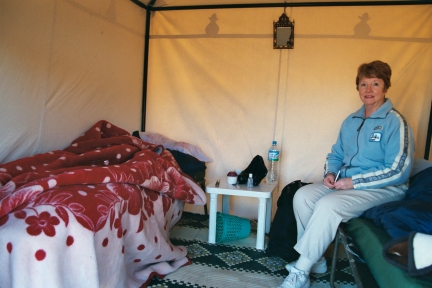
Every traveler was instructed to bring a pillow case for the pillos.
Lighting was provided by a candle on our camp table which I hung
from the ceiling like a chandelier.
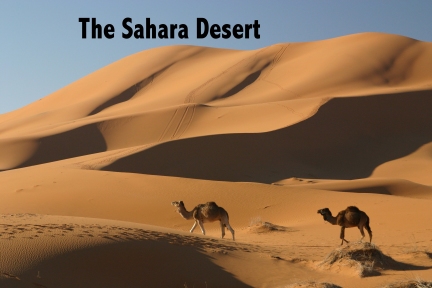
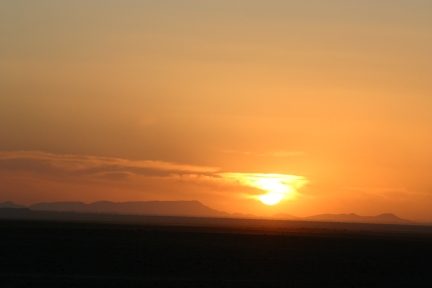
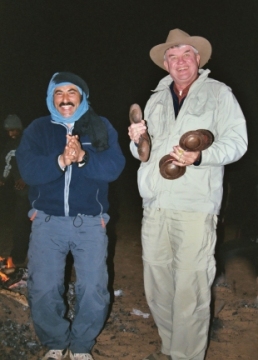
After supper a fire was built in desert and we
listened to traditional Berber music. I get my chance to play
the garagab (rattles) which are iron castanets to accompany daqqa music.
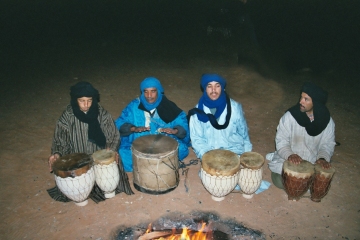
Most of the music is songs
accompanied by drum beats.
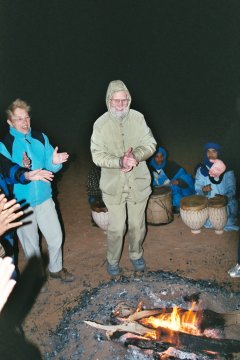
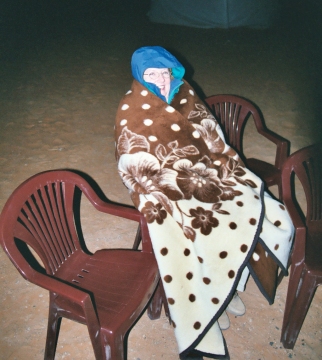
Some people warm themselves by dancing around the fire.
Fran thought it easier to snuggle up into a blanket.
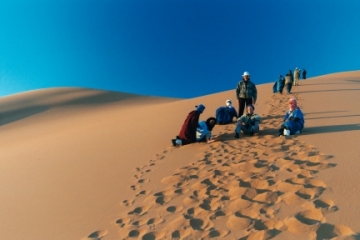
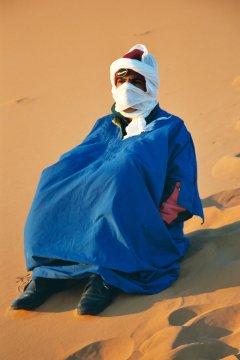
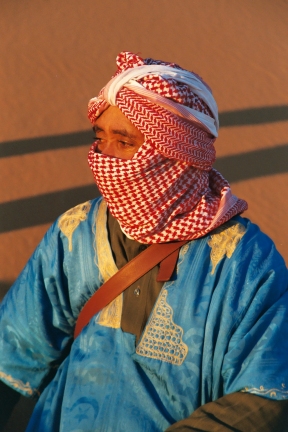
The Blue Men historically were nomadic Berber
traders who travel across the Sahara. The name comes from the blue dye
used to color their robes which would stain their skin
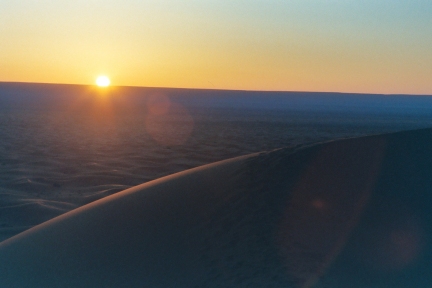
And this is the sunrise that we got up so early to see....
You be the judge. Personally I thought the sunset was prettier.
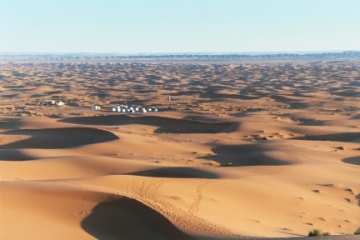
From the top of the dune we were able to look down on
our encampment.
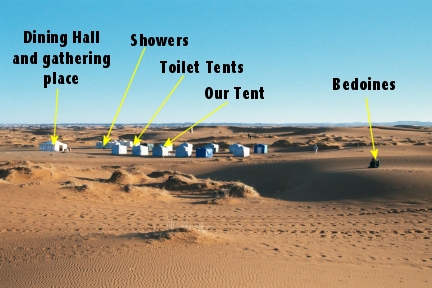
This is what our camp in the desert looked like.
Not exactly Bedouin design but more suitable for our needs.
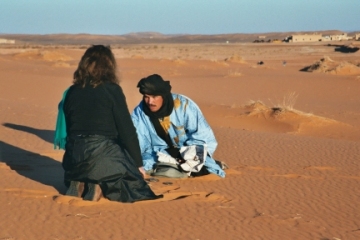
Unknown to us, when the Blue Men offered to help us up the
dune their real motive was to sell us polished fossels.
This I wish I had known in advance so I would have had
money with me so I could buy more of their treasures
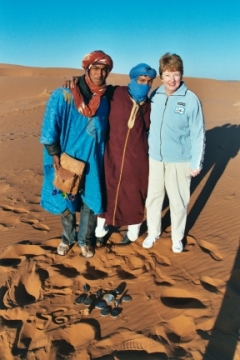
Fran was so happy to have someone pull her up the dune
which went like this - one step up, half a step step sliding down, etc.
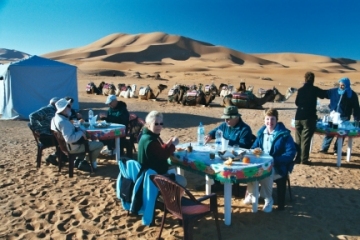
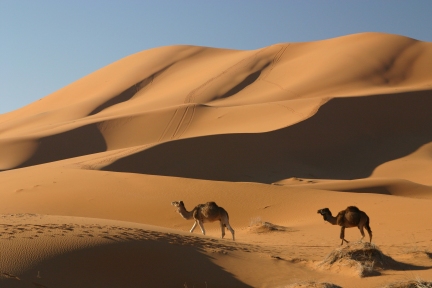
Other camels crossed the dunes looking for water or tuffs of grass.
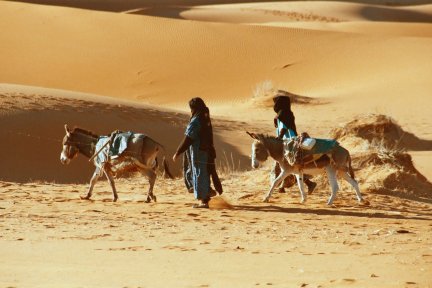
Bedouin women carrying water from the well to their
camp which may be several miles away

Getting on, or off, a camel is no easy task. They
first get up on their hind legs which almost throws you over the front of the camel

We left the first camp behind us and
for about an hour we were like Lawrence of Arabia as
we rode our "ships of the desert"
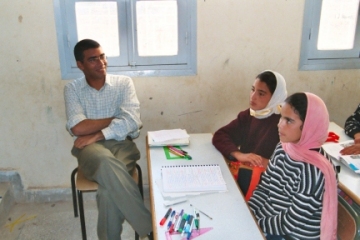
We have a chance to visit a school in a small desert village.
All the students are in one room. Boys to the right and girls to the left.
The teacher is proud to demonstrate the reading skills of his students.
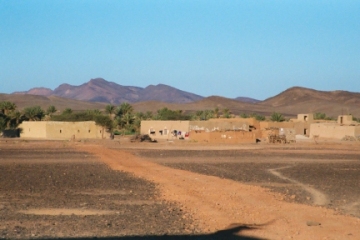
The small village of Marach, in the middle of the desert, is
isolated with very few amenities. Young teachers are assigned by the Minister
of Education and if they do well they are moved to larger towns or cities.
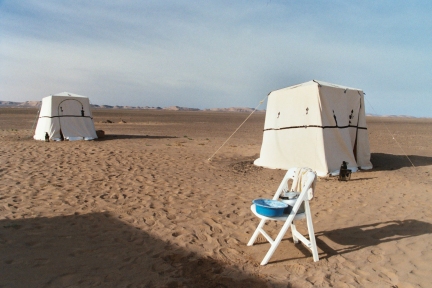
Toilet facilities were private, but primitive
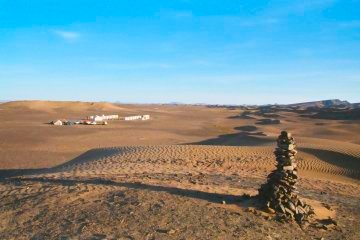
On our second morning in the Sahara as breakfast is
being prepared I took a hike through the sand dunes. It would be easy to get lost out here.
On a dune above our camp I build my totum which will last for a thousand years.
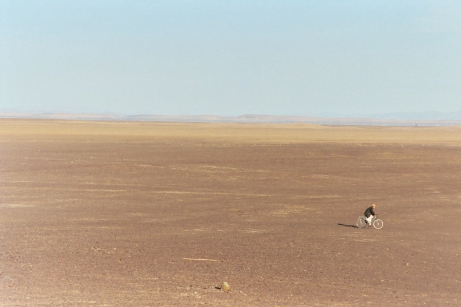
A bicycle is an alternative to means to cross
the desert and probably faster. To my surprise, the desert is mostly hard packed
rocks and sand. All the loose sand is blown into the dunes.
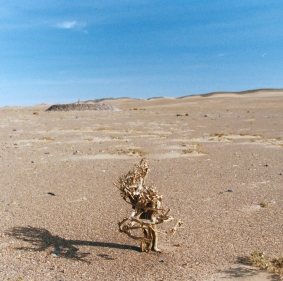
To give us a feel of the desert we start the
day off with a two mile hike.
In the background you can see a well ....
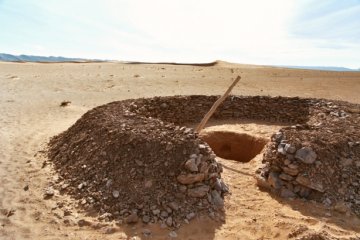
which is found in the middle of nowhere. I went as close to the
edge as I dared without falling in - I wanted to see if it was a dry
well but didn't want to disappear forever. I am assured the camels
and herders know its location well.
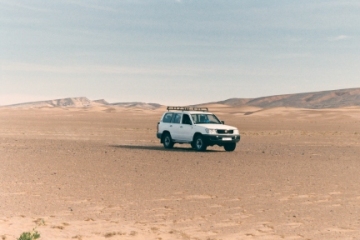
Some people are unable to walk or get tired before it is
finished. The stragglers are picked up by our jeeps as they fall behind.
After a long jeep ride though what seemed to be "the middle of nowhere"
we arrived at the camp of a Bodouin family. The nearest well was
about a mile and a half away.
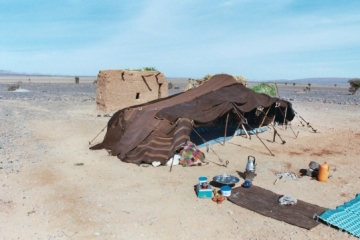
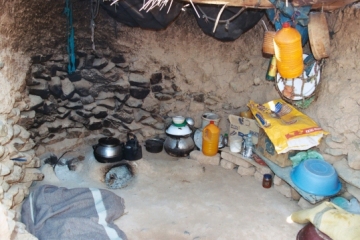
A small cooking hut made of stones contains the oven.
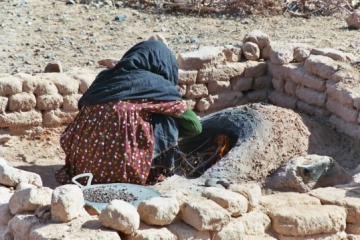
When it is hot the cooking is done in an outdoor oven.
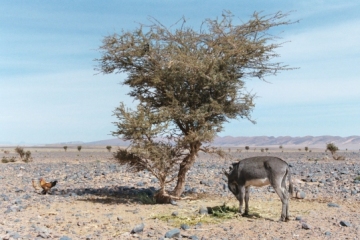
Livestock, a donkey and a chicken, have slim pickings.
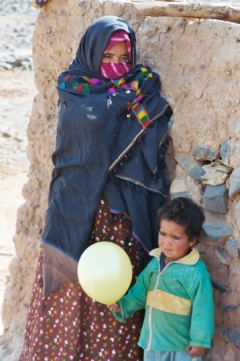
The Bedouin woman is shy and reluctant to have her picture taken.
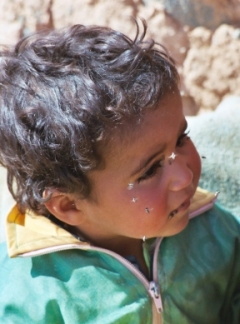
The children are naturally shy but courious about all the fuss.
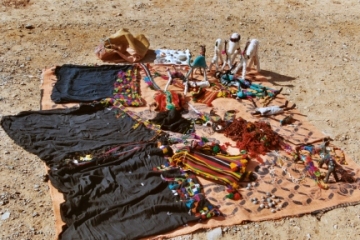
Selling some hand made articles is a source of cash.
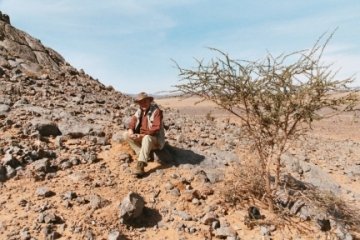
The whole Sahara was once under water
and is now a favorate location for fossel hunters.
After having mint tea we try our hand at searching for fossels.
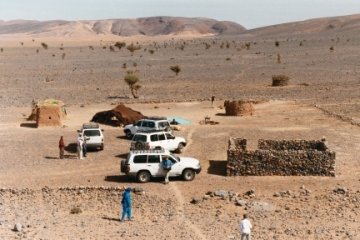
A view of the encampment from the hilltop shows how
bleak the land is.
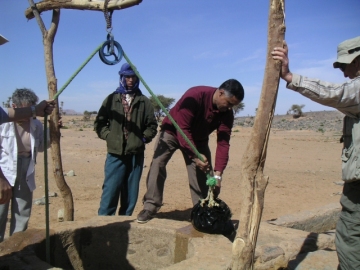
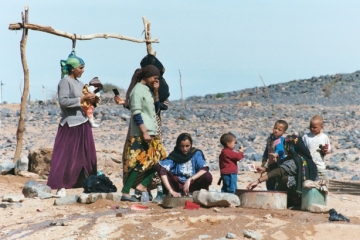
It may not be easy work but for the women
doing the family wash is a social affair.
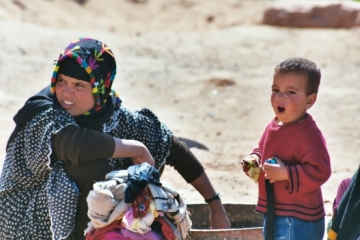
They all seem so young.....
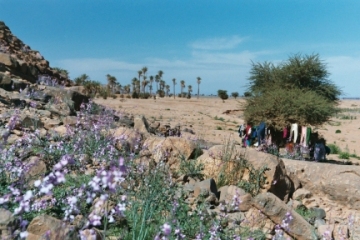
Along the riverbed flowers bloom.
Note the wash drying in the tree and
see the oasis in the distant background?
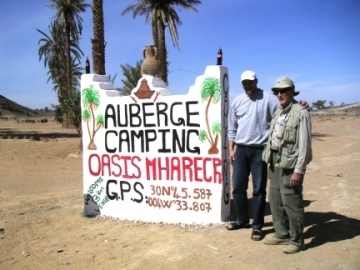
A lot of fossel hunters visit this area so it is
nice to know exactly where you are on your GPS.
Just a few degrees west of the prime meridian
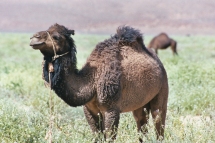
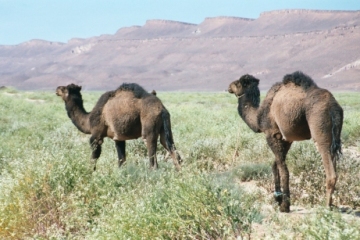
The camel's front feet are hobbled so they can't go far.
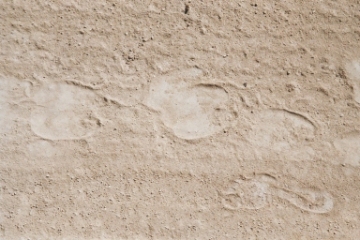
What does this picture tell you?
A barefoot boy following the camels....
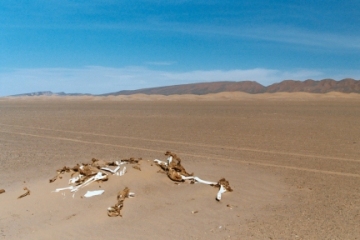
As we head back across the desert to our camp we are
reminded how unforgiving the desert can be - even for
a camel who doesn't find his way back to the water well.

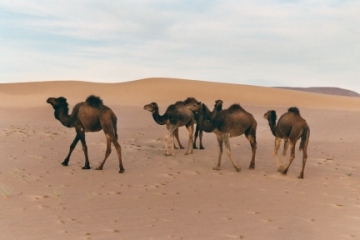
As I followed them they just walked ahead of me.
I soon became aware that I had to keep our camp site in vision at all times
because it would have been easy to loose all sense of location.
I thought these were wild camels but our guide assured me there was no such thing.
Camels are too expensive and valuable to be wondering around wild. They are allowed
to freely graze on what tuffs of grass they may find but they know their way back to the
water well - most of them that is - where the owners can gather them up.
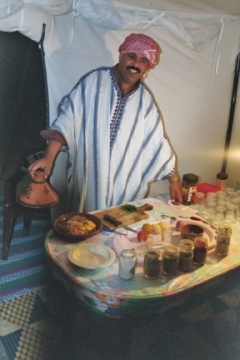
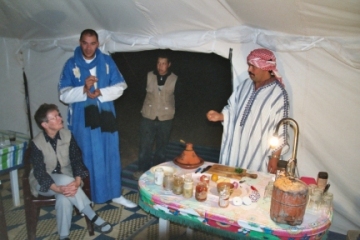
There are lots of questions and the recipe is given:
Preparing and Cooking the Tarjine
Chop one onion and one tomato and put them into bottom of Tarjen pot
chop garlic and add to pot
Mix:
1 pinch of cilantro
1/2 t salt
1/4 t pepper
1 heaping t cumin
1/2 t ginger
1/2 t paprika
a pinch of saffron
add olive oil and mix up the ingredients
stuff the mixture under the skin of the chicken
Place chicken in pot and cover and cook 15 minutes.
Add 1/4 cup water
cut potatoes into 1/4 pieces and stack around chicken
slice second onion and place slices over top of mixture
slice second tomato and place over top
cook for 1/2 hour
Add 1/4 cup water and add 1 lemon sliced on top
cook another 10 minutes.
Place olives (green) on top
sprinkle with celantro and cook another 10 minutes.
Eat and enjoy - Good luck.
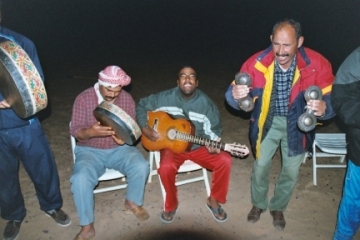
When we finished dinner another bonfire is built
and were treated to more Berber music.
Tonight is better though, because the musicians would sing a song
then we would sing a song. Surprisingly they knew the music,
but not the words to a lot of American campfire tunes.
We made quite a ruckus with "She'll be Comin' Around the Mountain",
and "Clementine", and singing rounds like "Are You Sleeping"
The Berbers knew the French words and it was a real hoot.

We danced around the fire and listened to the instruments.
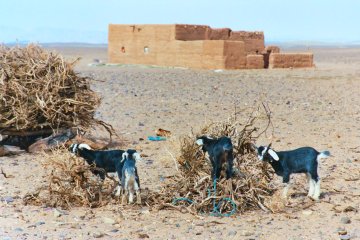
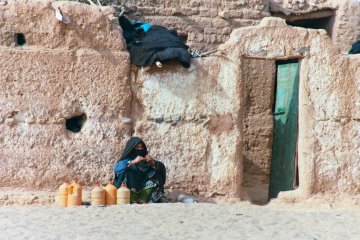
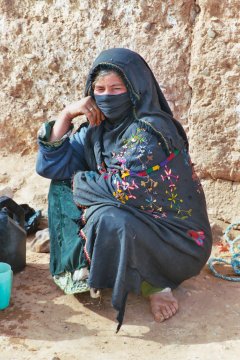
The Bedouin woman is dressed in the typical hand sewen combination shaw
head covering and veil.
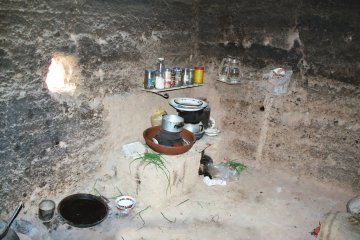
We are allowed into the kitchen to see where meals are cooked.
In the desert thick mud walls provide a shaded and cool area.
The only light is through the door and this window cut into the
side of the building.
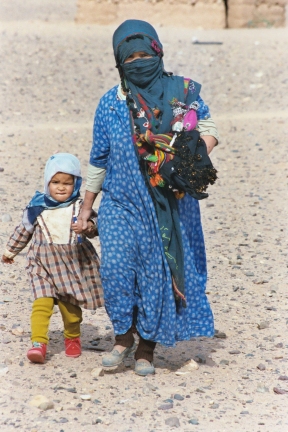
When we arrived a Bedouin woman, with child in tow,
brought out an armful of goods which was laid out to sell to us.
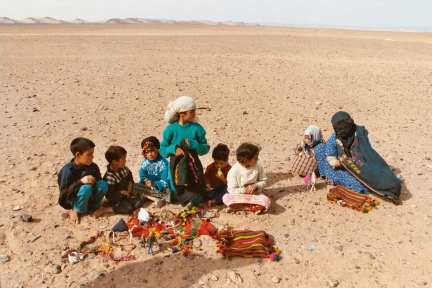
Once again hand made articles are shown to us.
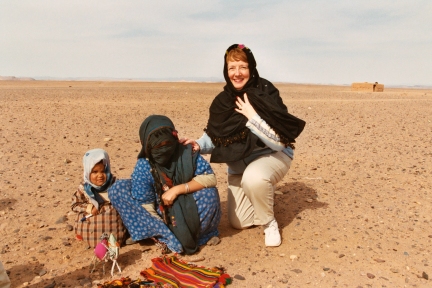
This time Fran bought a hand woven decorated scarf.

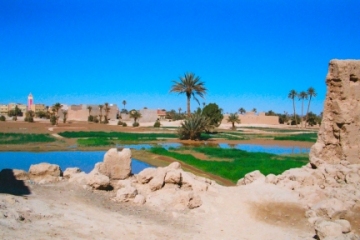
We are invited to a Berber home for mint tea in this small village.
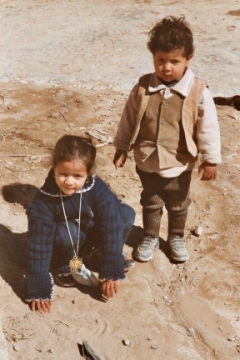
The children are shy to the big group of
people coming to their home.
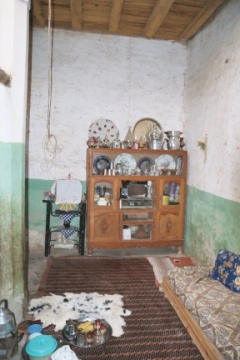
The typical Berber home consists of a kitchen
and a large room which serves as living room and bed room.
By tradition guests are honored by being served mint tea.
We all became enamored with the ceremony of brewing and serving the tea.
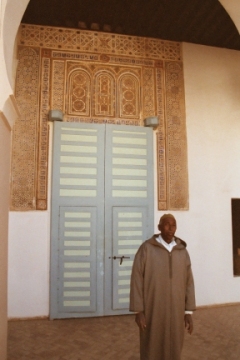
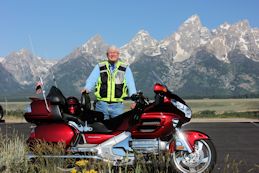
Belli at the Grand Titons, June 2015